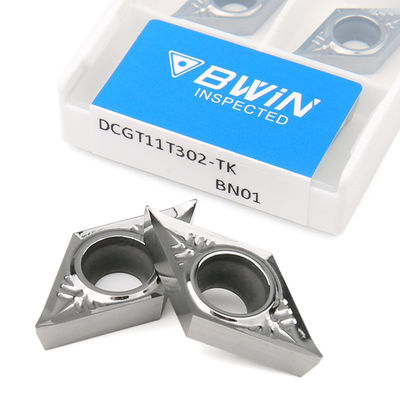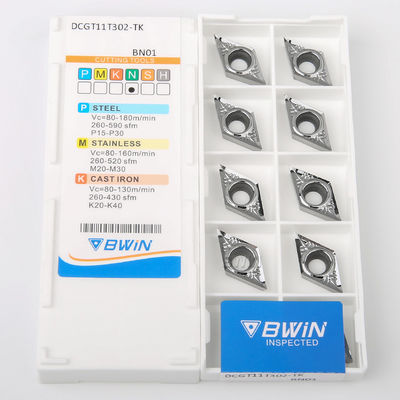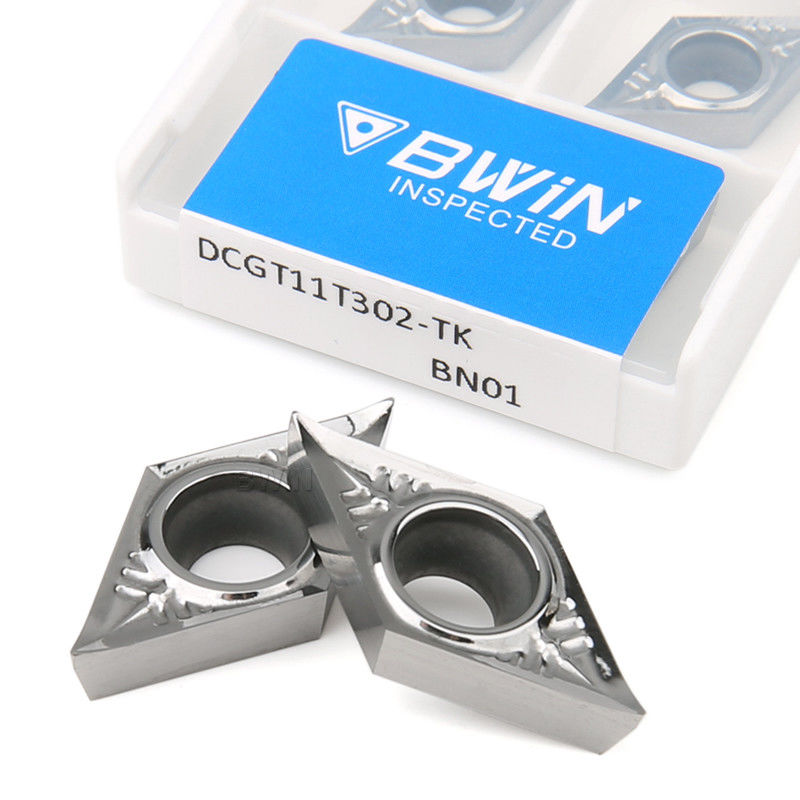DCGT Turning Carbide Inserts DCGT11T302 DCGT11T304 DCGT11T308 Uncoated For Aluminum
Product Details:
| Place of Origin: | China |
| Brand Name: | BWIN |
| Model Number: | DCGT11T302 |
Payment & Shipping Terms:
| Minimum Order Quantity: | 10pcs/box |
|---|---|
| Price: | Negotiable |
| Packaging Details: | Plastic box |
| Delivery Time: | 7 work days |
| Payment Terms: | T/T, Western Union |
| Supply Ability: | 1-10000pcs 7days |
|
Detail Information |
|||
| Product Name: | DCGT Carbide Aluminum Inserts | Material: | Tungsten Cnc Cutting Tools |
|---|---|---|---|
| Workpiece: | Aluminum | Usage: | Tooling |
| Color: | Uncoated | Coating: | Uncoated |
| Hardness: | HRC40-60 | Feature: | High Finish |
| Application: | Cnc Machining Tool | Package: | 10pcs/Box |
| Highlight: | Uncoated DCGT Inserts,DCGT Turning Carbide Inserts,Durable Carbide Inserts For Aluminium |
||
Product Description
Quick Detail:
- High quality substrate
- Wear-resistant coating
- Durable
- Smooth chip removal
- Stable quality
Description:
-
DCGT carbide lathe insert is made of uncoated submicron grain cemented carbide with good wear resistance and toughness; The unique design of the cutting edge adjusts the details of the aluminum alloy material, making the blade more durable and greatly improving the processing efficiency; The blade edge is sharp, the surface finish is high, the surface of the blade is smooth and nearly mirror. In addition, the blade edge is sharp, and the chip removal is smooth and non-stick during processing, which can reduce the blade loss rate.
Specifications:
|
Brand |
BWIN |
|
Model |
DCGT11T302/DCGT11T304/DCGT11T308 |
|
304Color |
Uncoated |
|
Workpiece |
Aluminium |
|
Type |
CNC Lathe Tools |
|
Material |
Tungsten Carbide Inserts |
|
Processing Type |
Medium Cutting |
|
Feature |
High quality substrate |
|
Wear-resistant coating |
|
|
Durable |
|
|
Smooth chip removal |
|
|
Stable quality |
|
|
Standard |
ISO |
|
Quantity |
10pcs/box |
|
Weight |
0.015kg |
|
Package |
Plastic Box |
|
Customized Support |
OEM, ODM |
Lead Time:
|
antity(pieces) |
1 - 3000 |
>3000 |
|
Lead time (days) |
7 |
To be negotiated |
![]()
|
I(mm) |
d(mm) |
t(mm) |
d1(mm) |
|
07 |
6.35 |
2.38 |
2.8 |
|
11 |
9.525 |
3.97 |
4.4 |
Notice:
-
Be careful not to mix two or several turning carbide inserts together;
-
Pay special attention to the protection of the cutting edge; Never touch or fall on the ground;
-
Pay attention to rust prevention, and then pay attention to whether the locking screw is loosened when adjusting;
-
When using the turning carbide inserts, if there is screw anti seize agent, it must be added to prevent the screw from sticking;
-
Assume that the turning carbide inserts encounters rust; It is not recommended to use abrasive paper or other rough grinding. It is recommended to purchase a polishing agent specially used for polishing. The particles are fine, much like toothpaste, which will cause less damage to the taper part of turning carbide inserts, and the polishing is smooth.
Applications:
Our turning carbide inserts could to be processed Alloy steel, Tool steel, carbon steel, stainless steel, Cast iron and Titanium alloy. Working material as following:
![]()
FAQ
1. Flank Wear? Higher cutting resistance,Notch wear on flank,Poor roughness of surface, or deterioration of accuracy.
Soft grades,Excessive cutting speed,Small flank angle,Low feed.
Select a higher,wear-resistant grade,Reduce cutting speed,Increase flank angle,Increase feed.
2. Crater Wear? Uncontrolled chip,Poor surface quality,when finishing High speed processing carbon steel
Soft grades,Excessive cutting speed,Excessive feed,The strength of chip breaker Insufficiet.
Change to a higher wear-resistant grade,Reduce cutting speed,Reduce feed,Select a higher strength chip breaker.
3. Chipping? Sudden fracture of cutting edge(rake face and flank),Instability insert life
Toughness insufficient,Excessive feed rate,Strength of cutting edge insufficient,Instability of the tool.
Select a tougher grade,Decrease feed rate,Increase honing of cutting edge(chamfering to rounding),Increase the stability and setting angle
4. Insert Fracture? Cutting resistance increased Poor surface roughness.
Toughness insufficient,Excessive feed rate,Strength of cutting edge insufficient,Instability of the tool.
Select a tougher grade,Decrease feed rate,Increase honing of cutting edge(chamfering to rounding),Increase the stability and setting angle.
5. Plastic Deformation? Variation of dimension Nose wear,cutting edge drape or passivating.when processing alloy steel Poor surface roughness
Soft grade,Excessive cutting speed,Excessive cutting depth and feed rate,Overheat on cutting edge.
Select a higher red hardness cutting material,Decrease cutting speed,Decrease cutting depth and feed rate,Select a higher thermal conductivity cutting material(CVD+sufficient coolant).
6. Build-Up-Edge? Workpiece dissove with Cutting edge Poor surface roughness when finishing,Cutting resistance increased,Cutting soft materials.
Cutting speed too low,Cutting edge obtuse,Unsuitable tool material. Increase cutting speed,Increase rake angle,Select small sticking force.






